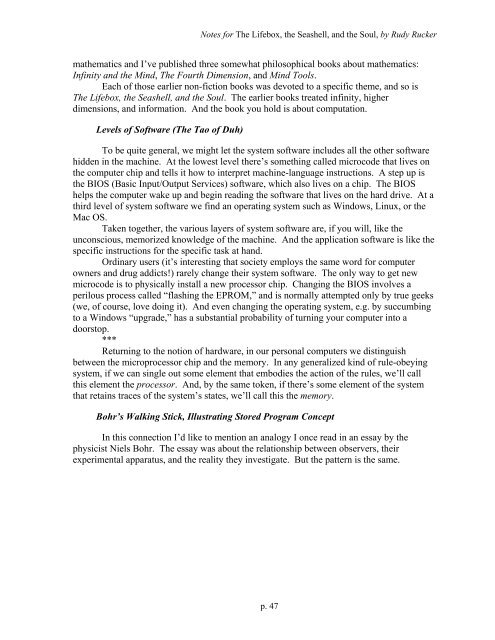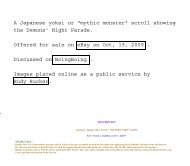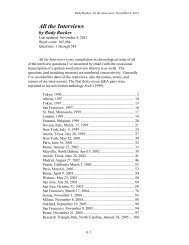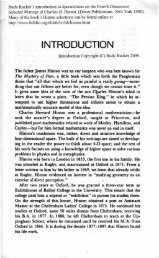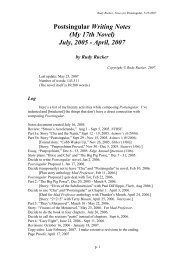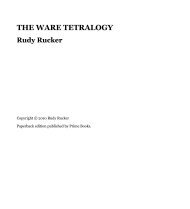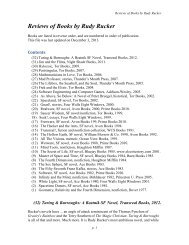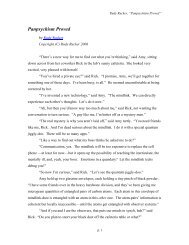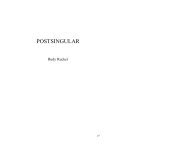Notes for the Lifebox, the Seashell, and the Soul - Rudy Rucker
Notes for the Lifebox, the Seashell, and the Soul - Rudy Rucker
Notes for the Lifebox, the Seashell, and the Soul - Rudy Rucker
Create successful ePaper yourself
Turn your PDF publications into a flip-book with our unique Google optimized e-Paper software.
<strong>Notes</strong> <strong>for</strong> The <strong>Lifebox</strong>, <strong>the</strong> <strong>Seashell</strong>, <strong>and</strong> <strong>the</strong> <strong>Soul</strong>, by <strong>Rudy</strong> <strong>Rucker</strong><br />
ma<strong>the</strong>matics <strong>and</strong> I’ve published three somewhat philosophical books about ma<strong>the</strong>matics:<br />
Infinity <strong>and</strong> <strong>the</strong> Mind, The Fourth Dimension, <strong>and</strong> Mind Tools.<br />
Each of those earlier non-fiction books was devoted to a specific <strong>the</strong>me, <strong>and</strong> so is<br />
The <strong>Lifebox</strong>, <strong>the</strong> <strong>Seashell</strong>, <strong>and</strong> <strong>the</strong> <strong>Soul</strong>. The earlier books treated infinity, higher<br />
dimensions, <strong>and</strong> in<strong>for</strong>mation. And <strong>the</strong> book you hold is about computation.<br />
Levels of Software (The Tao of Duh)<br />
To be quite general, we might let <strong>the</strong> system software includes all <strong>the</strong> o<strong>the</strong>r software<br />
hidden in <strong>the</strong> machine. At <strong>the</strong> lowest level <strong>the</strong>re’s something called microcode that lives on<br />
<strong>the</strong> computer chip <strong>and</strong> tells it how to interpret machine-language instructions. A step up is<br />
<strong>the</strong> BIOS (Basic Input/Output Services) software, which also lives on a chip. The BIOS<br />
helps <strong>the</strong> computer wake up <strong>and</strong> begin reading <strong>the</strong> software that lives on <strong>the</strong> hard drive. At a<br />
third level of system software we find an operating system such as Windows, Linux, or <strong>the</strong><br />
Mac OS.<br />
Taken toge<strong>the</strong>r, <strong>the</strong> various layers of system software are, if you will, like <strong>the</strong><br />
unconscious, memorized knowledge of <strong>the</strong> machine. And <strong>the</strong> application software is like <strong>the</strong><br />
specific instructions <strong>for</strong> <strong>the</strong> specific task at h<strong>and</strong>.<br />
Ordinary users (it’s interesting that society employs <strong>the</strong> same word <strong>for</strong> computer<br />
owners <strong>and</strong> drug addicts!) rarely change <strong>the</strong>ir system software. The only way to get new<br />
microcode is to physically install a new processor chip. Changing <strong>the</strong> BIOS involves a<br />
perilous process called “flashing <strong>the</strong> EPROM,” <strong>and</strong> is normally attempted only by true geeks<br />
(we, of course, love doing it). And even changing <strong>the</strong> operating system, e.g. by succumbing<br />
to a Windows “upgrade,” has a substantial probability of turning your computer into a<br />
doorstop.<br />
***<br />
Returning to <strong>the</strong> notion of hardware, in our personal computers we distinguish<br />
between <strong>the</strong> microprocessor chip <strong>and</strong> <strong>the</strong> memory. In any generalized kind of rule-obeying<br />
system, if we can single out some element that embodies <strong>the</strong> action of <strong>the</strong> rules, we’ll call<br />
this element <strong>the</strong> processor. And, by <strong>the</strong> same token, if <strong>the</strong>re’s some element of <strong>the</strong> system<br />
that retains traces of <strong>the</strong> system’s states, we’ll call this <strong>the</strong> memory.<br />
Bohr’s Walking Stick, Illustrating Stored Program Concept<br />
In this connection I’d like to mention an analogy I once read in an essay by <strong>the</strong><br />
physicist Niels Bohr. The essay was about <strong>the</strong> relationship between observers, <strong>the</strong>ir<br />
experimental apparatus, <strong>and</strong> <strong>the</strong> reality <strong>the</strong>y investigate. But <strong>the</strong> pattern is <strong>the</strong> same.<br />
p. 47


